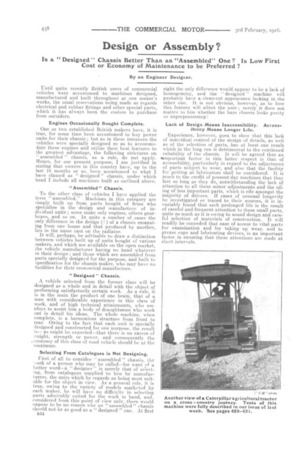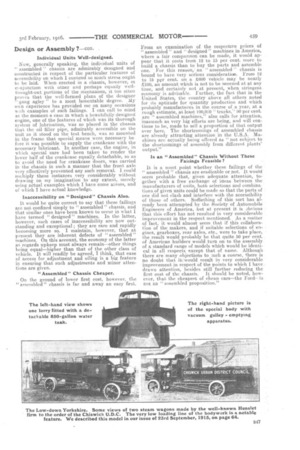Design or Assembly?
Page 14

Page 15

If you've noticed an error in this article please click here to report it so we can fix it.
" Designed " Chassis Better Than an "Assembled" One ? Is Low First Cost or Economy of Maintenance to be Preferred ?
By an Engineer Designer.
Until quite recently British users of commercial vehicles were accustomed to machines designed, manufactured and built throughout at one maker's works, the usual reservations being made as regards electrical and rubber fittings and other special parts, which it has always been the custom to purchase from outsiders.
Engines Occasionally Bought Complete.
One or two established British makers have, it is true, for some time been accustomed to buy power units for their chassis ; but as in these instances the vehicles were specially designed so as to accommodate these engines and utilize their best features to the greatest advantage, the following strictures on " assembled " chassis, as a rule, do not . apply. Hence, for our present purpose, I am justified in stating that owners in this country have, up to the last 18 months or so, been accustomed to what I have classed as " designed" chassis, under which head I include all machines built as outlined above.
"Assembled" Chassis.
To the other class of vehicles I have applied the term "assembled." Machines in this category are simplybuilt up from parts bought of firms who specialize in the design and manufacture of individual units ; sonic make only engines, others gearboxes, and so on. In quite a number of cases the only difference in the design (!) of a chassis emanating from one house and that produced by another, lies in the name cast on the radiator.
It will, perhaps, be advisable to draw a distinction between vehicles built UT) of units bought of various makers, and which are available on the open market, the vehicle manufacturer having no hand whatever in their design ; and those which are assembled from parts specially designed for the purpose, and built to specification for the chassis maker, who may have no facilities for their economical manufacture.
Designed" Chassis.
A vehicle selected from the former class will be designed as a whole and in detail with the object of performing satisfactorily certain work. As a rule, it is in the main the product of one brain, that of a man with considerable experience in this class of work, and of high technical attainments, who employs to assist him a body of draughtsmen who work out in detail his ideas. The whole machine, when complete, is a harmonious structure from front to rear. Owing to the fact that each unit is specially designed and constructed for one purpose, the result is— as might be expected—that there is no excess of Nv eigh t, strength or power. and consequently the .economy of this class of road vehicle should he at the maximum.
Selecting From Catalogues is Not Designing.
First of all to consider " assembled " chassis, the ',fork of a, person who may be called—for want of a better word—a " designer " is merely that of selecting, from catalogues supplied to him by manufacturers, the units which he regards as being most suitable for the object in view. As a general rule, it is true, owing to the variety of models marketed by each maker, he will have no difficulty in selecting parts admirably suited for the work in hand, and, considered from this point of view only, there would anpear to be no reason why an "assembled" chassis should not be as good as a " designed " one. At first
B44
sight the only difference would appear to be a lack of homogeneity, and the "designed " machine will probably have a clean-cut appearance lacking in the other one. It is not obvious, however, as to how this feature will affect the user ; surely it does not matter to him whether the bare chassis looks pretty or unprepossessing!
Lack of Design Means Inaccessibility. Accessibility Means Longer Life.
Experience, however, goes to show that this lack of individual control of the design of details, as well as of the selection of parts, has at least one result which in the long run is detrimental to the continued reliability of the chassis. It will be agreed that an ounnortant factor in this latter respect is that of accessibility, particularly in regard to the adjustment of parts subject to wear, and also that the facility for getting at lubricators shall be considered. It is much to the credit of present-day machines that they last so long as they do, notwithstanding the lack of attention to all these minor adjustments and the oiling of less important parts, which is rife amongst the majority of drivers. If cases of unusual longevity be investigated or traced to their sources, it is invariably found that such prolonged life is the result of careful and frequent attention to these small parts, quite as much as it is owing to sound design and careful selection of materials of construction. It will readily be conceded that ease of access to vital parts for examination and for taking up wear, and to grease cups and lubricating devices, is an important factor in ensuring that these attentions are made at short intervals. Individual Units Well-designed.
Now, generally speaking, the individual units Of " assembled" chassis are admirably designed and constructed in respect of the particular features of accessibility on which 1 contend so much stress ought to be laid. When erected in a chassis, however, in conjunction with other and perhaps equally wellthought-out portions of the mechanism, it too often proves that the well-formed plans of the designer
gang agley " to a most lamentable degree. My own experience has provided me on many occasions with examples of such failings. I can call to mind at the moment a case in which a beautifully-designed engine, one of the features of which was its thorough system of lubrication, was so placed in the chassis that the oil filler pipe, admirably accessible on the unit as it stood on the test bench, was so mounted in the frame that special means were necessary be fore it was possible to supply the crankcase with the necessary lubricant. In another case, the engine' in which special bare had been taken to render the lower half of the crankcase equally detachable, so as to avoid the need for crankcase doors, was carried in the chassis in such a Manner that the front axle very effectively prevented any such removal. I could m uitiply these instances very considerably, without drawing on my iniagination to any extent, merely using actual examples which I have come across, and of which I have actual knowledge.
Inaccessibility on "Designed" Chassis Also.
It would be quite correct to say that these failings are not confined simply to " assembled" chassis, and that similar ones have been known to occur in what I have termed "designed" machines. In the latter, however, such cases of inaccessibility are now outstanding and exceptional; they are rare and rapidly becoming more so. I maintain, however, that at present they are inherent defects of " assembled " machines. On this account, the economy of the latter as regards upkeep must always remain—other things being equal—higher than that of the other class of vehicle. It will readily be agreed, I think, that ease of access for adjustment and oiling is a big feature in ensuring that such adjustments and minor attentions are given.
"Assembled" Chassis Cheaper.
On the ground of lower first cost, however, the " assembled " chassis is far and away an easy first. }from an examination of the respective prices. of " assembled " and " designed " machines. in America, where a fair comparison can be made, it would appear that it costs from 12 to 15 per cent. more to build a chassis than to buy the parts and assemble one. For this reason, an " assembled " chassis is bound to have very serious consideration. From 12 to 15 pr cent, on a 1;600 vehicle may be nearly £100, an amount which is not to be sneezed at at any time, and certainly not at present, when stringent economy is advisable. Further, the fact that in the United States, the country above all others noted for its aptitude for quantity production and which probably manufactures in the course of a year, at a rough estimate, at least 100,000 "trucks,' 90 per cent. are " assembled machines," also calls for attention, inasmuch as very big efforts are being, and will continue to be, made to sell a proportion of that output over here. The shortcomings of assembled chassis are already attracting. attention in the U.S.A. Machines are actually being offered as "not subject to the shortcomings of assembly from different plants' output."
Is an "Assembled" Chassis Without These Failings Feasible ?
It is a moot point whether these failings of the " assembled " chassis are eradicable or not. It would seem probable that, given adequate attenticin together with a free exchange of ideas between the manufacturers of units, both selections and combinations of given units could be made so that the parts of one did not clash and interfere with the accessibility of those of others. Soething of this sort has already been attempted by the Society of Automobile Engineers of America, but at present it is obvious that this effort has not resulted in very considerable improvement in the respect mentioned. As a matter of fact, it would almost seem that if this collaboration of the makers, and if suitable selections of engines, gearboxes, rear axles, etc., were to take place, the result would probably be that quite 50 per cent. of American builders would turn on to the assembly of a standard range of models which would be identical in all respects except that of name. Although there are many objections to such a coarse, there is no doubt that ili'would result in very considerable improvement in respect of the points to which I have drawn attention, besides still further reducing the first cost of the chassis. It should be noted, however, that the cheapest of cheap cars—the Ford– is not an "assembled proposition."






















